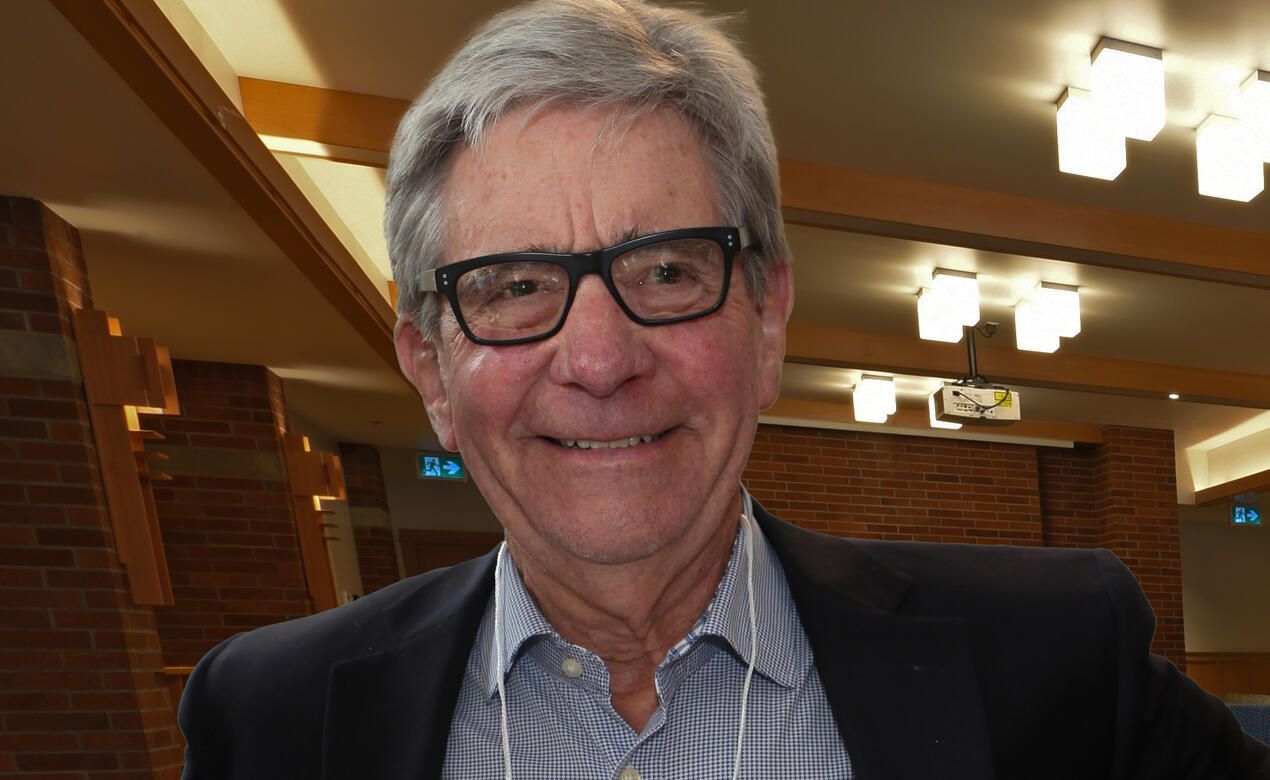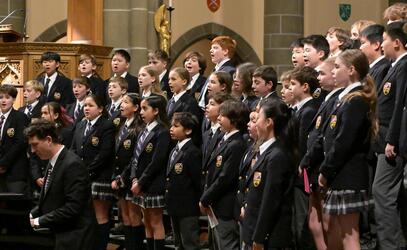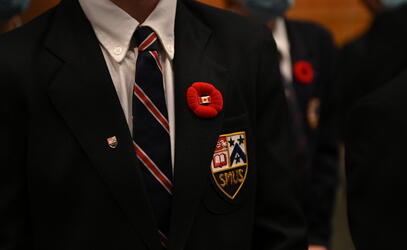
On Thursday, October 19, we had the pleasure of welcoming members of our community back to campus to host our annual Founders and Benefactors Dinner.
This event holds a longstanding tradition of recognizing and celebrating the philanthropic contributions of individuals in our community who actively support financial aid and endowment. It serves as an opportunity to bring everyone together with the current students who directly benefit from their generosity.
The occasion consistently showcases remarkable speeches from both donors and recipients, shedding light on the profound impact of a SMUS education and the life-changing effect of financial aid. This year proved no different, with David Angus delivering a speech on behalf of John Herpers, an address that resonated deeply with the attendees.
Below, you will find the highlights from John Herpers' speech:
In the beginning of 2000, I was invited by Joe Small, a close family friend and a Jesuit priest, to visit him in Nairobi, Kenya. Our plan was to visit Nairobi for 1-2 weeks and go on safari the third week.
When I arrived in Nairobi, Joe drove me to a friend’s home. I was surprised that it was a one room home. There was no shower, toilet or bedroom. It was old and in need of repair. In conversing with his friend, I learned that there was a common bathroom and shower on the property. Since he was not married, he often ate with neighbours who cooked food outside of their homes.
We stayed for a short time and went on our way. Joe lived with about fifteen other men on a large piece of property with many buildings that had bathrooms, a kitchen and a dining room for our meals. And thank God there were showers, bath tubs and toilets in the sleeping quarters.
His fifteen friends were from Europe and North America. Their purpose was to help the poor, find them jobs and help them find schools for their children. Joe who was a retired teacher would tutor kids if they required assistance with their academics. He loved working with the kids and was very popular.
During my visit, I was shocked at the poverty in Nairobi. I watched families gathered together. Most were unemployed, had no accommodations and walked the streets. They begged for food. There was restricted or no water, few toilets or shower facilities.
But there were a few neighbourhoods that had medium sized houses. Joe explained that many Europeans either owned or worked for companies. They lived in decent neighbourhoods, sent their kids to either public or private schools but, according to Joe, these neighbourhoods only represented a small percentage of the population.
During the second week, I was asked if I would like to visit a school called Starehe, a boy’s school in Nairobi. The school was started in 1959 in two Quonset huts donated by Kenya Shell and BP Oil. And in the fall of 1959 seventeen boys entered.
When I walked on the campus, I saw kids who were dressed in uniforms walking to and from classes. When I walked into the administrative office, I was introduced to the general administrator who took me around the campus. I immediately compared the school to our St. Michaels University School. The buildings were impressive; the students were welcoming and inquisitive. They were athletic and played games throughout the school year.
According to my guide, there were 1200 students at Starehe. The students come from African, European, and other universities the world over. Starehe receives about 20,000 applications every year. After rigorous interviews and rigid testing there are only 250 students accepted.
Starehe is a charitable school. At least 70% of its students receive free tuition and the rest attend at a reduced rate.
When my campus tour was finished, I was very impressed with the school. I was impressed with the campus, the students and the academics. Any student who attended Starehe had an opportunity to attend a university, learn about their fellow students, play competitive sports, receive three meals per day and had the opportunity to overcome poverty.
When I arrived home in Portland, Oregon, I found a Jesuit middle school, Saint Andrew Nativity School, which is located in the inner city of Portland. It is the only tuition free private middle school in Oregon. Students who are admitted come from very financially challenged families.
The students enter Grade 6 and many test at a third grade level. The student teacher ratio is 14:1. There is a 48 hour school week. The graduation rate from Nativity School is 98-100% and the students are accepted at many private high schools. 98% graduate from the high school and 88% go on to college.
In 2004, I began volunteering at St. Andrew Nativity School. I mentored students who wanted exposure to the Portland community. I spent time reviewing their reading, writing and math skills. After a few years, I invited a few active and retired lawyers and executives to speak to the students about their youth and their careers. The students were impressed and asked good questions.
I thought about these kids attending St. Michaels University School. They would learn to make decisions on their own, be challenged by the school’s staff, have a challenging academic schedule, an international culture and sports programs and live with students who could become lifelong friends.
I spoke to Rob Wilson and John Davis about having a Nativity Graduate attend SMUS. We visited Nativity School, toured the school and met with the President. When we made our proposal the President was very inquisitive. She had questions like who will pay for the tuition? Is a child to be taken to a foreign country and stay there for four years? What would their mother feel about her child attending a boarding school? Many Nativity students hadn’t been in downtown Portland.
The President wanted me to meet with the board. Because I was educated and boarded at University School, I could explain that the school provided me with excellent teachers, a challenging academic schedule, sports programs and housing with other boarders who were from other countries. I found great friends, some of whom I am still in contact with today.
A board member challenged me with an interesting question. How would a Nativity student who came from a challenging family situation in Portland adjust to St. Michaels University School? I informed him that the staff, a mentor and fellow students would help the Nativity student adjust to the environment.
The President called the following day to tell me that the Nativity board supported sending a student to SMUS. However, she thought it might be a difficult challenge to find a student whose parents would support their child attending a boarding school in another country. I responded that if there was a candidate we would arrange to have the parents and student visit the school.
Our first Nativity graduate was Musu Ofosu. She was born in England, moved to Portland, Oregon and was interested in attending SMUS. Her mother had attended a British boarding school and thought Musu would thrive at the school. She entered in the fall of 2007 and graduated in the spring of 2011. She moved to London and completed her degree in marketing. She is now married and has a young son. And she is employed in marketing.
Our second student, Paris Lowe, entered SMUS in the fall of 2009. After her first three weeks as a student, I visited the campus. I was sitting in the quad and heard Paris’s voice. She knew everyone’s name; she seemed to know the whole student body. I went to one of her classes and she contributed to the class. She graduated in 2014 and attended the University of San Diego. After she graduated, she was accepted to Johns Hopkins University to study for a master’s degree in Public Health. She is married, has two young children and is working in public health.
Our third student, Leah Sparkman, entered SMUS in the fall of 2013. She became involved in sports, theatre and was an excellent student. During her Grade 12 school year, she applied for a scholarship to Santa Clara University and was awarded a full academic scholarship in the spring of 2017. She is now employed by Nike in Austin, Texas.
Our fourth student, Marbella Ramirez, graduated in 2022 and is completing her final year at community college in Portland.
Our fifth student, Jahiel McCoy, graduated from Nativity in June 2023 and entered SMUS this fall. He is bright, friendly and engaging.
In closing, my involvement in SMUS has been a journey from the fall of 1960 to the present. I arrived in the fall of 1960; I was fourteen years old. My mother and I arrived on the Princess Margaret; we arrived at the school and after unloading my luggage, my mother left to take the Princess Margaret back to Seattle. I was homesick and missed my parents. I played rugby, basketball, but I was too big and clumsy to run track. I did well academically and graduated in 1964. I had formed great relationships with fellow students and masters like Rob Wilson, Ian Mugridge and Nick Prowse.
I am extremely proud of the Nativity SMUS relationship and the Nativity students who have graduated from SMUS. I want to thank Rob Wilson, Shara Campsall, and Mark Turner for their support of this relationship and for their exceptional support of the Nativity students who have attended and graduated from SMUS.


